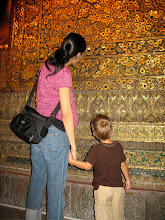Last summer, I read The Read-Aloud Handbook , by Jim Trelease. I found it to be informative and inspiring, although much of it was confirmation of things I already knew or suspected to be true. Still, it was good to have all of the evidence for reading aloud laid out in one place, and it was even better to have some concrete ideas and suggestions to incorporate in our reading routine.
, by Jim Trelease. I found it to be informative and inspiring, although much of it was confirmation of things I already knew or suspected to be true. Still, it was good to have all of the evidence for reading aloud laid out in one place, and it was even better to have some concrete ideas and suggestions to incorporate in our reading routine.
One of the ideas that I latched on to was a mother's practice of giving her children a new book every week. Of course, in the States, we would go to the library and regularly check out 15 children's books at a time, so one book a week is pretty paltry in comparison. However, given that our reading selection is fairly limited here, I thought this would be a good practice to institute in our home. So, after a great deal of research and stocking up, we have been able to maintain a pretty regular weekly routine of a new book every Saturday evening. Kaya knows the routine and looks forward to his new books -- his Saturday Stories, he calls them -- and will remind us if we forget.
In case other families are interested in starting a routine like this one, I have put together the full list of all the books we gave Kaya this school year. These are all available in paperback, which means they are more affordable and easier to transport. I hope this list can be of use to other families who are looking for great reading material for their kids!
Picture Books (in alphabetical order, because I am crazy):
A Bad Case of StripesCaps for Sale
Carmine: A Little More Red , by Melissa Sweet
, by Melissa Sweet
Harry and the Dinosaurs and the Bucketful of Stories , by Ian Whybrow
, by Ian Whybrow
Harvey Potter's Balloon Farm , by Jerdine Nolen
, by Jerdine Nolen
How Are You Peeling, by Saxton Freymann
How I Spent My Summer Vacation, by Mark Teague
Inch by Inch, by Leo Lionni
Harvey Potter's Balloon Farm
How Are You Peeling, by Saxton Freymann
How I Spent My Summer Vacation, by Mark Teague
Inch by Inch, by Leo Lionni
If I Built a Car , by Chris van Dusen
, by Chris van Dusen
Jack's Garden, by Henry Cole
Koala Lou, by Mem Fox
Library Lion, by Michelle Knudsen
Jack's Garden, by Henry Cole
Koala Lou, by Mem Fox
Library Lion, by Michelle Knudsen
Possum Magic , by Mem Fox
, by Mem Fox
Me and My Dad, by Alison Ritchie
Miss Smith's Incredible Storybook , by Michael Garland
, by Michael Garland
Me and My Dad, by Alison Ritchie
Miss Smith's Incredible Storybook
The Paper Crane , by Molly Bang
, by Molly Bang
Snow, by Uri Shulevitz
Souperchicken, by Mary Jane Auch
Strega Nona, by Tomie dePaola
Thunder Cake
Tyrannosaurus Drip, by Julia Donaldson
What Pete Ate from A to Z , by Maira Kalman
, by Maira Kalman
When Sophie Gets Angry -- Really, Really Angry , by Molly Bang
, by Molly Bang
When Sophie Gets Angry -- Really, Really Angry
Nonfiction
First Encyclopedia of Dinosaurs
Magic Tree House Nos.1-26
Nos.1-26
Pippi Longstocking
Stuart Little , by E.B. White
, by E.B. White
Special thanks go out to both sets of grandparents, who provided quite a few of these books. We hope to be able to continue this tradition for the next school year as well. Kaya still has about 80 books on his Amazon wish list, so we have plenty of choices... and we are always open to new suggestions of other great books for our kiddo!
Special thanks go out to both sets of grandparents, who provided quite a few of these books. We hope to be able to continue this tradition for the next school year as well. Kaya still has about 80 books on his Amazon wish list, so we have plenty of choices... and we are always open to new suggestions of other great books for our kiddo!











